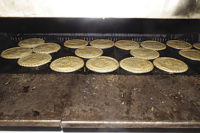Although the James Skinner Baking Co., Omaha, NE, maintains a highly diversified bakery business, its core ethos stems from the elegant, deceptively simple notion of 100 layers. Every batch of dough that forms the basis of its core Danish products undergoes a process whereby it’s progressively folded upon itself and sheeted until it has achieved the mathematical certainty of at least 100 layers. It then rests for a full day to proof at a controlled 34° F, slowly building signature flavor all the while. Only then is it ready to form into the dozens of sweet baked goods bearing the J. Skinner name and offered through in-store bakeries from coast to coast.
View Extended Slide Show from James Skinner Baking
Historical precedent
This story begins back in 1911, when brothers Lloyd M. and Paul F. Skinner opened a diversified food business in Omaha, producing baked goods and pasta, among other varied pursuits—including product releases like Quick-Ade, what many consider the first powdered fruit drink mix, and the world-famous breakfast cereal, Raisin Bran. The family continued its various food-industry pursuits throughout the decades. Upon returning from his service during World War II, Lloyd purchased the pasta and bakery business from his brother, and his son, Lloyd E. Skinner, eventually took over the business.
The J. Skinner story picks up again in 1983, when James Skinner, together with his father, Lloyd, purchased another Omaha bakery. Initially, the bakery’s sole purpose was to provide baked goods for a regional grocery chain. Within a few years, though, the grocery chain went under, leaving James with the options of selling the bakery or seeking new customers. Eventually opting for the latter, James secured a large account co-packing for a prominent U.S. bakery brand. In the years that followed, James able to acquire more co-packing accounts, and also expanded into offering private label for in-store bakeries across the country.
The quality of the bakery’s products eventually led James to consider creating his own brand and, in 2009, J. Skinner was born.
Inside the difference
The J. Skinner brand includes the tagline, “Modern Artisan Baking,” and various interpretations of “artisan” surface these days to help food businesses differentiate themselves. “The ‘artisan’ tagline comes from our production methods,” says David Skinner, marketing manager, James Skinner Baking. “We follow an Old World-style dough method. We age our dough for 24 hours. A lot of companies don’t do that.”
Allowing the dough to retard for 24 hours is a commitment to the process that comes at the expense of increased throughput. “It’s one of the pillars of the company—we don’t waver on the quality of the product,” says Shawn Bushouse, CFO for the company. “That’s our competitive advantage. A lot of our competitors will go in and beat us on price. It’s very easy to make a more-basic sweet dough product, something that you’re just proofing up.”
Bushouse notes that once consumers try the product, “Then we’ll have a customer for life.”
The marketing group at James Skinner Baking performs some in-depth customer analytics that have revealed a heavy base user of the products—strong consumer loyalty and regular repeat purchase. “We’re having the same folks come in and get it into the basket each week,” says Bushouse.
Stimulating growth
Skinner notes that once the J. Skinner brand hit the market, it changed the business across all functions. “It obviously was a driver in shaping our manufacturing environment and supply chain, but it also drove growth and character as our sales and support functions had an opportunity to show similar escalation,” he says. “The growth has enabled us to bring in some phenomenal talent across the organization.”
The last few years have seen James Skinner Baking become what Bushouse calls “a three-dimensional company,” which now includes aspects like category analysis and development. “We have a sales support team we installed that, at the retailer level, is conducting analysis.” This includes suggesting specific products for target retailer demographics and price points. “For a lot of customers, we actively manage their inventory with them,” he says, “to make sure that they are set up for success at the store level. We’re bringing a grocery background into the in-store bakery in terms of service to the customer.”
Today, J. Skinner’s branded sales have eclipsed the co-packing and private-label businesses. “Our most-recent ventures have been foodservice and national accounts, with our latest facility in Paris, TX, feeding those customers,” says Skinner. James Skinner Baking purchased the Texas facility in late 2011 to better meet volume demands. “We produce sweet dough and croissants in the Paris facility, with future expansions coming in the form of compressed dough and snack cakes,” he notes. The company estimates that 75 percent of business today goes to the in-store bakery (including both branded and private-label products) and 25 percent is foodservice.
Bushouse notes that private-label customers almost invariably come to them with set specifications for desired products, and that the team has grown highly precise in meeting cost requirements.
The company distributes to all 50 states, Canada and Mexico, and overseas expansion is a possibility in the future. “We are in talks with some of the largest European retailers right now,” says Bushouse. Retail channels served include traditional grocery, warehouse/club and discount, with “just a trace amount of convenience stores,” he notes.
While the company has a consistent presence across the U.S. Skinner cites the Northeast as a particularly strong area for sales. “With a strong population of European decent, our Old World Danish and brand has really resonated with the folks on the East Coast,” he says.
The products are shipped frozen with a year shelf life, ready to thaw and display for sale. Bushouse notes that most of the Danish products have a shelf life of about seven to 10 days, and that the shelf life of some of the muffin products can exceed 20 days.
“One notable upside to strong volume growth and consistent SKU mix is the ability to invest in targeted automation,” says Skinner. “We completed the largest automation project in company history in 2014, and we will continue to drive an aggressive automation plan through 2015. We have a strong continuous improvement team that, by structure, identifies and executes projects across the year, which allows us to offer a premium product in a very reasonable pricing structure.”
The J. Skinner lineup
“When we established the brand, we had two variations of Danish, a sweet roll and a cinnamon roll,” says Skinner. “To stay up with trends in the marketplace, we wanted to create an innovation center.”
The innovation center is located at corporate headquarters in Omaha and home to conceptual R&D, experimentation with new concepts and sometimes consumer preference panels. “A lot of it is like a Willy Wonka inspired type of thing,” says Skinner. Dennis Nolan, director of product development for the company, spearheads much of this work.
“Our product range for the brand includes thaw-and-sell Danish strip, gourmet muffins, Danish rings, sweet rolls, crumb cakes, cornbread, cinnamon rolls and individual Danishes,” says Skinner. “For foodservice, co-packing and national accounts, we offer individual bulk Danishes, croissants, cinnamon rolls, muffins and basically any sweet good bakery item that our customer can dream up. We take pride in working closely with our customers to tailor items to their specific needs.”
One of the bakery’s most-recent introductions is the J. Skinner Triple Flavor-fest Ring, a ring of pull-apart Danishes that feature cheese, raspberry and apple fillings. “The product has been one of our most-successful new items launches to date,” notes Skinner.
Even as the branded side of the business has grown, co-manufacturing and private label remain part of the company’s strategy. “Over the years, we have maintained fantastic relationships with a core set of the nation’s largest names in bakery and proudly produce quality products under their quality names,” says Skinner.
A current private-label project is based on the Triple Flavor-fest Ring, but on a larger scale. The ring includes a dozen cinnamon rolls with cheese, raspberry and apple fillings, arranged in a ring, then topped with a streusel crumble and drizzled with frosting. Bushouse notes that a certain degree of variability is desirable, reinforcing the artisan nature of the product.
Navigating the trend winds
“There are several emerging trends across all of our avenues of business,” says Skinner. “When we’re talking about the in-store bakery, we’re witnessing a change in the average shopper demographic. Millennials now dominate that landscape, and our branded products strive to cater to their needs.”
Health and wellness also prevail across the board these days. “What we’re noticing is the influence of the health-conscious consumer—they want it all, but it really comes down to how the customer wants to address that need,” says Skinner. “Whether it’s portion control with miniature items or adding functional ingredients, we’re very in-tune with the needs of the consumer and our customers.”
One co-manufacturing customer has reportedly seen strong sales of a product manufactured by Skinner that combines both portion control and better-for-you ingredients in its miniature whole-grain muffins.
Portion control can come into pay with variables like calorie count per serving, particularly with foodservice customers. The company also offers several J. Skinner “Perfect for Two” products, with two pastries per clamshell, which includes a microwave-safe tray—something Bushouse says is perfect for the “growing two-individual households across the United States.”
Another way Skinner stays in touch with the market is through social media, on Pinterest, Facebook and Twitter. For a recent new product release on the East Coast, he notes the company used Facebook’s demographic targeting tool to spread the word within a highly targeted range based on gender, age, where they live and where they shop. He also uses social networks to interact with consumers, send out recipe ideas, such as using the cinnamon rolls to create breakfast sandwiches, or holiday-themed recipes using J. Skinner cornbread.
Packaging notes
When James Skinner Baking launched its J. Skinner brand, it did so via external branded sleeves around the products. “We utilize this platform, in conjunction with our social media campaigns, to communicate directly with the consumer on new recipes, new products and other information related to their favorite products,” says Skinner.
This approach also affords James Skinner Baking flexibility. When creating new products, such as seasonal offerings—pumpkin Danishes in fall, or berry crunch in spring—the plant simply prints new sleeves to integrate into the packaging lines. The company has also created Texas-specific labels for products from the Paris, TX, plant and distributed in the state to add marketing muscle.
After all, resonating with its ever-expanding customer base is second-nature to this artisan baker.







